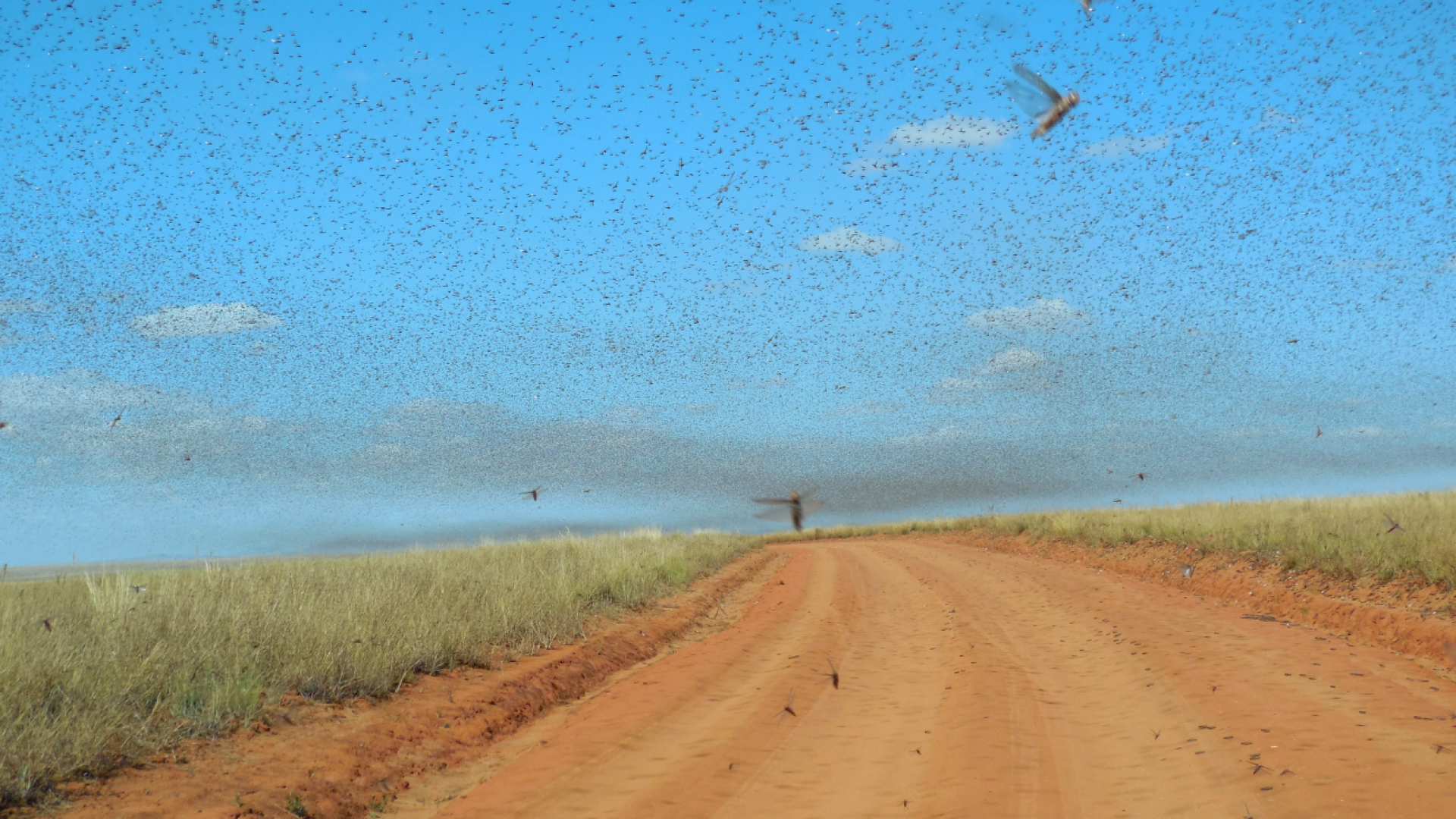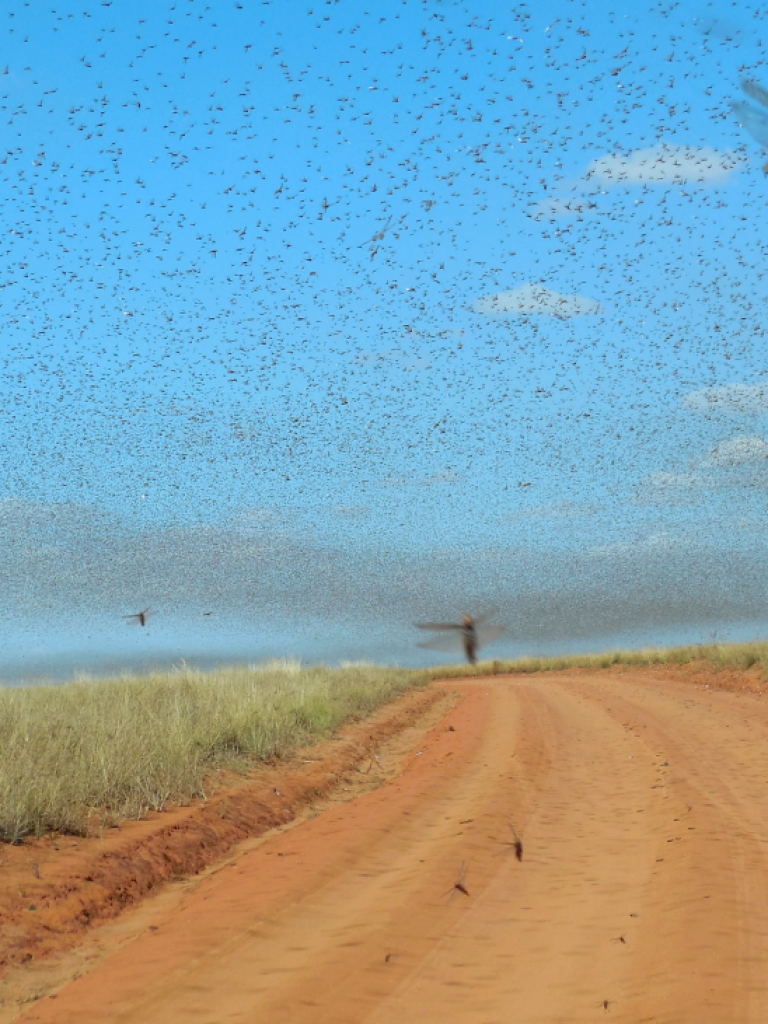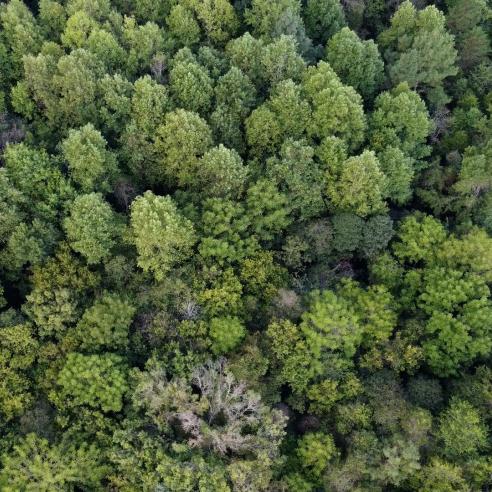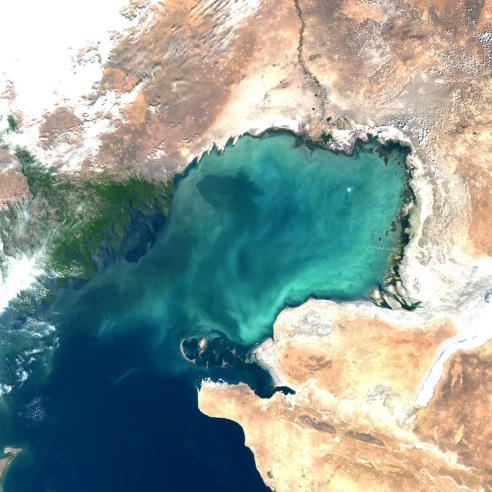
Tracking desert locusts with satellite services
This year brought a locust crisis to eastern Africa, threatening food supplies in an already troubled time.


In this blog post, we catch up with the activities of the IGAD Climate Prediction & Applications Centre (ICPAC), a climate centre tracking the locusts in East Africa, and see how EUMETSAT’s satellites and data helped mitigate this crisis.
16 November 2020
23 September 2020

The locust plague
Desert locust swarms are a pestilence of biblical proportion. Coming in waves ever since ancient times, they ravage crops that supply food to communities and livestock – in only one day, a small swarm can consume the food of 35,000 people. One locust alone is merely a type of grasshopper, but when climate conditions and other complex factors lead to a surge in population, they can swarm in groups of up to billions.
This year has seen some of the worst swarms in decades arrive in the Horn of Africa. The first wave at the end of 2019 destroyed 70,000ha of farmland in Somalia and Ethiopia, and 2,400km of pastureland in Kenya. A second wave brought the locusts back just as fresh crops were growing and introduced swarms to Uganda and South Sudan. Right now, most outbreaks are under control, but new swarms are coming in from Yemen, which has a limited capacity to control such outbreaks. What can we do to fight against these swarms?
Fighting a plague
ICAPC, based in Kenya, has had a busy year. As a Regional Climate Centre, ICPAC provide services such as climate forecasting, environmental monitoring and disaster risk management for the Horn of Africa, using weather satellite data and other information broadcasted via EUMETSAT’s dissemination system, EUMETCast.
These services are particularly crucial for a region prone to extreme climate events such as droughts and floods, and heavily dependent on locally-sourced agriculture. The additional challenge of the locust swarm this year, the worst for the region in a quarter of a century, was met by finding innovative ways to use the data already being received, at a time when all members were simultaneously feeling the impacts of the COVID-19 pandemic.
Forecasting locust movement
According to Kenneth Kemucie Mwangi from ICPAC, Thematic Assistant to the GMES and Africa initiative, the key to stopping the spread of a locust swarm is to identify the areas locusts go to breed, and then immediately eradicate the eggs or newly hatched hoppers with pesticides. The faster one can respond, the greater the chances of stopping a new generation; the focus is on how best to forecast the movement of breeding locusts.
By passing on this information to ministries in the affected regions, decision makers can arrange interventions for high-risk areas. By presenting locust risk maps and information such as predicted locust movement and ground data to governments and partners in control every two weeks, ICPAC provided advance warning early enough to make a difference.

These predictions come after considering a multitude of factors. Firstly, the trackers follow all the latest literature in the scientific community, about the optimal conditions for locust surges. Next, they follow the status of the existing locust populations. Are they swarming? Are they breeding or feeding? This information is not easily available and mainly comes from ground-based reports and observations. Finally, they evaluate the areas of greatest risk for locust-breeding grounds, and advise decision makers to intervene there as soon as possible.
This risk evaluation comes from a simple mathematical model derived from the World Meteorological Organization (WMO) literature on weather and locust migration. Locusts that want to lay eggs are yellow, cannot fly very far, and are looking for moist soil to settle in. Reaching a breeding site before the eggs hatch is fantastic success enabled by all of this data and forecasting, and mitigation procedures, including pesticides and burning, can then prevent a new swarm.

Eyes in the sky
EUMETSAT supports these efforts by providing ICPAC with weather, climate and environmental observations, such as vegetation indices and humidity values. The Metop meteorological and Sentinel-3 Copernicus satellites are our eyes in the sky, broadcasting their data to users via EUMETCast. Both satellites are operated by EUMETSAT.
Metop (EUMETSAT Polar System)
- The three Metop satellites, Metop-A, -B and –C, sit in low Earth orbit, at an altitude of 817km above the Earth.
- Operating since 2006, Metop satellites were jointly established by EUMETSAT and ESA, and work in conjunction with the USA’s NOAA satellite system.
- Metop ASCAT soil moisture data are disseminated to users in Africa via EUMETCast
- The Metop system observes the global atmosphere, oceans and continents, returning data every two hours.

Sentinel-3 (EC - Copernicus)
- Sentinel-3 is part of the Copernicus Earth observation series of satellites, imaging the whole planet from low Earth orbit.
- Sentinel-3 is jointly operated by EUMETSAT and ESA to deliver ocean and land observation services.
- NDVI vegetation indices are provided by Copernicus Global Land Services and are disseminated to users in Africa via EUMETCast.
- Find out more about the Copernicus programme here.

From the Copernicus Global Land Service, vegetation indices (also known as NDVI data) indicate how green an area is. By comparing these values to previous years, we can see where vegetation is flourishing, which are prime real estate for brooding locusts.
Another way to track suitable areas is to follow the moisture. Generally, in hot and dry countries, pests seek damp conditions to hatch eggs. Rather than tracking rainfall, which has varying impacts depending on the terrain, forecasters look at parameters such as soil moisture and relative humidity. Soil moisture values come from EUMETSAT’s own Metop polar-orbiting satellite, as a product of the ASCAT instrument.
Finally, 10-15 day weather forecasts provide further useful context about wind direction and rainfall, which will influence the path of the locusts in flight. Relative humidity and climate data come as part of the European Centre for Medium-Range Weather Forecasts (ECMWF) data distributed via EUMETCast.

Status of the outbreaks
As of the end of August 2020, there is effective control of the locust spread over the majority of the affected regions. In Uganda, only few swarms remain, and in Kenya, three counties are still affected.
Kenneth explains: “Those three counties were among those impacted by the movement restrictions caused by COVID-19, during the time that intensified control of the locusts was needed most. The coronavirus hit the region when ICPAC and IGAD’s call for action and action advisories reports reached the government through the IGAD Ministers of Agriculture. This caused a break in control and with no movement between counties possible, there could be no immediate response.”
Internal travel restrictions weren’t the only issue; a slowdown of international shipping limited the delivery of pesticides ordered from Japan. Despite the lack of a timely response, ICPAC’s role was still a success, as time went on to show the model had correctly predicted the correct locations of the outbreak. As mobilisation becomes possible again, and with the continued assistance of predictions and coordinated response plans from ICPAC, it is hoped that it is only a matter of time before the remaining regional swarms are controlled.
However, the outlook is not so great for Ethiopia and Somalia, who, still in the midst of an outbreak, have already lost two rounds of crops to the ravenous swarms.
Kenneth stipulates that “Ethiopia and Somalia are in what we call the ‘red zone’ right now, as they have been affected by successive swarms, with new ones reported coming in from Yemen. From the beginning, they were the first landing point [on the continent], where the locusts invaded right as the crops were about to be harvested.”
This unfortunate coincidence of timing did not go without consequences, as Ethiopia and Somalia had to harvest their crops rapidly before they were fully mature. Two harvests from these two countries, with a combined population of around 124 million people, suffered from the swarm, while countries further west had already harvested a large part of their crops before the locusts arrived.
ICPAC continues to communicate regularly with decision makers in ministries in the hopes of eradicating these remaining locust populations. There is cause for optimism, as the winds are changing direction, reducing the number of new swarms coming in to the coast. With continued intervention and serendipitous weather conditions, the end of the 2019/2020 locust plague of Eastern Africa may be in sight.
Future prospects
Tracking desert locusts is a complicated task achieved with many different data products from several satellites.
“We didn’t invent new techniques to tackle this, but new ways to implement the existing index data we had for other services”, says Kenneth. In other words, locust forecasting was an outcome of combining other types of forecasting already taking place, such as wind and moisture predictions.
The goal for now is to get smarter for future migratory pest invasions. Partners have approached ICPAC with funding and partnerships to develop a more advanced version of their existing models. Kenneth hopes that by using the same fundamental successful approach, they will be able to predict migratory swarms for any user, across the spectrum of world weather-based pest issues.
Studies have shown that powerful cyclones and other extreme weather events exacerbate the likelihood of outbreaks such as the one this year, and as the global temperatures continue to increase, we will see more such extreme events and consequently more swarms. As this locust crisis in Africa resolves, EUMETSAT’s satellites will continue to provide data that help mitigate similar problems around the world.
To learn more about how Earth observation impacts Africa, join us on 24 September for a webinar, where five Regional Climate Centres will discuss future prospects for monitoring the climate, agriculture and water resources. Visit the event page to register here.





